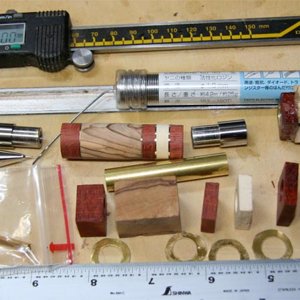I've been playing with segmenting lately, using brass shim stock, aluminum drink can material, acrylics, woods, etc.
I had a blank I glued up that had several 35° cuts made with my bandsaw. The wood was padauk. For each cut I carefully trued and flattened the face on my disc sander, roughed up all mating surfaces of the metal and the wood, and used a good amount of 5-minute epoxy to glue them together. I did the glue up over several days, going with a single piece at a time. I used my vise, a 90° grip jig, and a clamp to ensure that there was really solid contact being made, things were held square, and nothing was slipping and sliding around. The brass pieces I was using were 0.5mm thick, and ever so slightly smaller in square dimensions than the blank, so I wouldn't have any protrusions.
After glue-up, I made sure the blank had straight sides all square to each other with my disk sander. No gaps, no protrusions. It was as clean I blank as I've ever worked with. The blank sat there at room temp in my shop for several days while I waited for some drill bits to arrive in the mail, so I'm confident the epoxy was fully cured.
When attempting to drill, I used my pen jaws on my Nova chuck to hold the square blank, a Jacobs chuck in my tailstock, and went excruciatingly slowly whenever hitting an interface of wood and brass. I was doing a smaller pilot hole with my HSS brad point 8mm bit that I intended to later open up with the larger 10.5 and 12.5mm bits necessary for the pen I'm making. I was pulling out frequently to avoid heat buildup or packing swarf into the flutes of the bit. I used parrafin wax on the bit to help lubricate a bit.
No matter how carefully I went, the glue joints would fail. Usually it seemed like the edge of the drill bit would catch on the metal and just rip it off of the wood.
There's got to be some way to drill this stuff properly. Do I need to use non-brad-point bits? Step up from a 1/8" bit in tiny increments until I hit my target diameter? Use a different adhesive? Not sure where I went wrong.
I had a blank I glued up that had several 35° cuts made with my bandsaw. The wood was padauk. For each cut I carefully trued and flattened the face on my disc sander, roughed up all mating surfaces of the metal and the wood, and used a good amount of 5-minute epoxy to glue them together. I did the glue up over several days, going with a single piece at a time. I used my vise, a 90° grip jig, and a clamp to ensure that there was really solid contact being made, things were held square, and nothing was slipping and sliding around. The brass pieces I was using were 0.5mm thick, and ever so slightly smaller in square dimensions than the blank, so I wouldn't have any protrusions.
After glue-up, I made sure the blank had straight sides all square to each other with my disk sander. No gaps, no protrusions. It was as clean I blank as I've ever worked with. The blank sat there at room temp in my shop for several days while I waited for some drill bits to arrive in the mail, so I'm confident the epoxy was fully cured.
When attempting to drill, I used my pen jaws on my Nova chuck to hold the square blank, a Jacobs chuck in my tailstock, and went excruciatingly slowly whenever hitting an interface of wood and brass. I was doing a smaller pilot hole with my HSS brad point 8mm bit that I intended to later open up with the larger 10.5 and 12.5mm bits necessary for the pen I'm making. I was pulling out frequently to avoid heat buildup or packing swarf into the flutes of the bit. I used parrafin wax on the bit to help lubricate a bit.
No matter how carefully I went, the glue joints would fail. Usually it seemed like the edge of the drill bit would catch on the metal and just rip it off of the wood.
There's got to be some way to drill this stuff properly. Do I need to use non-brad-point bits? Step up from a 1/8" bit in tiny increments until I hit my target diameter? Use a different adhesive? Not sure where I went wrong.

